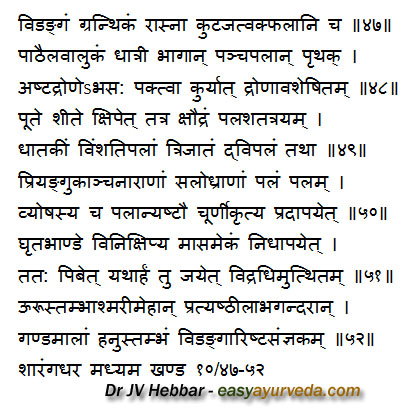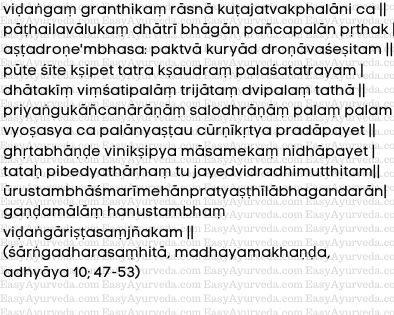Vidangarishta is an Ayurvedic medicine used in treatment of abscess, fistula etc. It is a liquid Ayurvedic medicine.Vidangarishta contains 5 – 10 % of self generated alcohol in it. This self generated alcohol and the water present in the product acts as a media to deliver water and alcohol soluble active herbal components to the body. Vidangarishta is also known as Vidangarisht, Vidangarishtam, Vidangarista, etc
Table of Contents
ToggleReference and dose
Reference: Sharangdhara Samhita, Ayurvedic Formulary of India
Vidangarishta dose: 12 – 24 ml. one or two times a day, usually advised after food.
If needed, it can be mixed with equal quantity of water.
With western medicines
Seek your doctor’s advice if you are taking this product along with other western (allopathic/modern) medicines. Some Ayurvedic herbs can interact with modern medicine.
If both Ayurvedic and allopathic medicines are advised together, then it is best to take allopathic medicine first, wait for 30 minutes and then, after a gap of 15 – 30 minutes, take Ayurvedic medicine or as directed by the physician.
Can this be used while taking Homeopathic medicine?
Yes. This product does not react with homeopathic medicine.
With supplements like multivitamin tablets, Omega 3 fatty acids etc?
Yes. Generally, this product goes well with most of the dietary supplements. However, if you are taking more than one product per day, please consult your doctor for an opinion.
Uses
Vidangarishta uses:
Vidangarishta is used as herbal remedy for abscess,
It is also used in the treatment of thigh cramps, fistula, urinary calculi, torticollis.
Traditional uses – Abscess – Vidhradi
Stiff thigh, thigh cramps – Urustambha
Urinary calculi – Ashmari
Urinary disorders, diabetes – Meha
Distended, Regid abdomen resembling paralytic Ileus – Pratyashtila
Fistula in ano – Bhagandara
Cervical lymphadenitis – Gandamala
Locked jaw, torticollis – Hanustambha
It also acts as a digestive and carminative.
It is useful to promote strength of bones and joints.
It acts as an excellent
anti inflammatory and analgesic mediicne.
It is used for the treatment of ankle pain, ankle twitch, slipped disc, sprain, back spasm, backache, back
injury, stiffness of muscles, Coccyx pain
Partially useful in (other
medications might be required)
Avascular necrosis
Sensory-neural hearing loss
Hypothyroidism
Ankylosing spondylitis
Pain related to SLE
Diet
Avoid deep fried foods, heavy-to-digest non veg foods, fast foods and aerated drinks, smoking and excess alcohol. These can irritate stomach and intestinal lining. These also may increase Tridosha.
Watch the video
Side effects
In prescribed dosage, it is not having any side effects.
Contents
Vidangarishta ingredients:
Vidanga (Embelia ribes) – Fruit – 240 g
Granthika – Long pepper – Root – 240 g
Rasna (Pluchea lanceolata) – Root / leaf – 240 g
Kutaja (Holarrhena antidysenterica) – Stem bark – 240 g
Patha (Cyclea peltata) – Root – 240 g
Elavaluka – Prunus cerasus – Stem bark – 240 g
Dhatri – Amla – Fruit – 240 g
Water for decoction – 98.304 liters
Boiled and reduced to – 12.288 liters.
Kshaudra – Honey – 14.4 kg
Prakshepa herbs-
Dhataki (Woodfordia fruticosa) – Flower – 960 g
Twak – Cinnamon – 96 g
Patra – Cinnamomum tamala – leaf – 96 g
Ela – cardamom – 96 g
Priyangu – Callicarpa macrophylla – Flower – 48 g
Kanchanara -Bauhinia variegata – Stem bark – 48 g
Lodhra – Symplocos racemosa – stem bark – 48 g
Shunti – Ginger – 384 g
Maricha – Black Pepper – 384 g
Pippali – Long pepper fruit – 384 g
Method of manufacturing
The first set of herbs is taken in coarse powder form, added with water, boiled, reduced to said proportion. Thus obtained Kashaya is filtered. To it, Prakshepa herbs and honey are added. The contents are kept sealed in a vessel that is smeared with a coat of ghee, for one month. After fermentation, the contents are filtered and preserved.
Shloka- Sanskrit verse
Safe for kids?
It is safe to use this medicine in lower dose, in children above 3 years of age.
Pregnancy and lactation –
During pregnancy it is best avoided.
It can be taken during lactation period, under doctor’s advice, for a short period of time.
Expiry date and storage
Expiry date: 10 years from the date of manufacture.
Storage: Store in a cool place in tightly closed amber coloured bottle, protect from light and moisture.
Manufacturers:
Nagarjuna – Vidangaarishtam
Please consult your doctor before taking this medicine.
This article is written by Dr. Janardhana V Hebbar BAMS, MD (Ayu), PGDPSM, Managing Director, Easy Ayurveda Hospital.
It is reviewed by Dr. Raviganesh Mogra BAMS, MD (Ayu), Chief Medical Officer, Easy Ayurveda Hospital











29 thoughts on “Vidangarishta – Uses, Side effects, Dose And Ingredients”
Is it useful for worms
Used for treatment of ring worms also
Vidangarishta is used as herbal remedy for abscess. It is also used in the treatment of thigh cramps, fistula, urinary calculi, torticollis.
Which company manufactures this
Dabur, Nagarjuna
Is this used for weight gain?
No.
How long should this medicine be taken ..Ie how many days ….Side effect any if taken for a longer period
It is usually advised for a period of 1 month time. No side effects in the prescribed dose.
Will it kill my healthy bacteria?
No.
Is it used as digestive?
Can this be used for deworming of less than a month old pups? Some wid worms in their stool.
No. The pups should be at least 4 months old to use it.
Hi, the suggested medicines are good to go even with the mucous complaint.
5ml mixed with 10ml of water at night can be given for 1 month of time.
Which ayevdeic is good for de wormb.wht the the dost n wht is duration .? Help me out
Vidangarishta is very good.
Advisory for Fissure or fistula patient or not….
It can be used in fissure / fistula patient.
If someone has to take Vidangarishta after meal. Then can they have curd rice? As curd is known to have beneficial bacteria. Does Vidangarishta react to curd? Is it some kind of viruddha ahara
Hi Sir, We live in USA and need this medicine for my Son who is 8 years old… Please Reply, how can I buy this medicine.
Can it be given for a 1 year old toddler?
I would like to share one thing on my butt boil are going and coming again even some place
ring warm so can I use the this
Kindly suggest me.
Yes, but please consult a doctor directly.
Hello,
Which purgative or laxative medicine should be taken for effective purging of worms along with Vidangarishta? Thanks.
Manibhandra gulam / Trivrit lehyam. But this needs doctor’s prescription
What amount of dosage I can give to 5 yrs and 7 yrs old for deworming and for how many days?
Usually 3 ml, mixed with 10 ml water, 2 times a day after food. But please consult an Ayurveda doctor directly for the right advice.